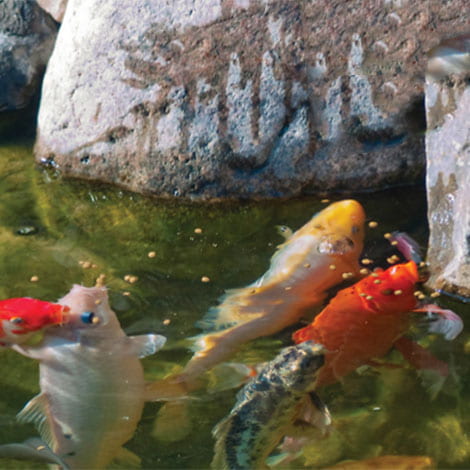Last Updated: February 26, 2024
Asked by: Steve of Wallingford, PA
A: You can help prepare your pond fish for their winter hibernation, or torpor, with The Pond Guy Spring & Fall Fish Food when the water temperature dips below 50 degrees Fahrenheit.
Spring and fall pond fish food is a wheat-germ blend packed with vegetable protein, amino acids, and digestive enzymes. This diet helps fish transition into and out of winter, is easy to digest, and promotes robust immune systems to fend off diseases.
How do you know when to start feeding fall pond fish food? Here are three clues:
- Temperature: Use your submersible thermometer to monitor the water temperature throughout the seasons to determine which food is best. Switch to wheat-germ-based spring and fall fish foods when the water temperature is between 40 and 50 degrees Fahrenheit. Start feeding nutrient-dense food like The Pond Guy Growth & Vibrance Fish Food when the water stays above 50 degrees consistently.
- Fish Mobility: Are your koi and goldfish moving more slowly than usual? That's another clue that it's time to switch to a lighter food. Fish are cold-blooded and naturally slow their activity in cooler water as their bodies prepare for winter torpor.
- Feeding Interest: As the fish slow their activity and require less food to fuel their metabolisms, they won't be as interested in the tasty morsels as they are in the summer. If your koi and goldfish turn into picky eaters late in the year, it's time to switch to a lighter diet.
Are you wondering when to stop feeding koi for winter? As soon as water temperatures drop below 40 degrees, it's time to stop feeding your fish. Don't worry about how long koi can go without food in winter—they won't starve! During torpor, fish need very few calories and live comfortably off stored fat deposits. Just keep that spring and fall fish food ready for their first big meal when you start feeding koi after winter (whenever the water temperature stays between 40–50 degrees)!
Learn More About Feeding Koi in Winter
If you have additional questions about when and how to transition your fish through winter, reach out to our pond experts, who are always happy to help! Plus, read more fish-feeding advice below:
Read More Articles
When to Start Feeding Fish
Switching to Fall Fish Food
Choosing Fish Food

